Abraliopsis sp. E
Richard E. YoungIntroduction
Abraliopsis sp. E is known from a single small (21 mm ML), but mature, male taken in the Central Equatorial Pacific at 7°15'N, 149°54'W.
Brief diagnosis:
An Abraliopsis (Micrabralia) ...
- without long, bare, distal region on the non-hectocotylized (left)arm IV.
- without blue photophores between Medial and Lateral Head Series.
- with photophores in distinct series on mantle.
Characteristics
- Arms
- All arms lack tubercules; left ventral arm without special modifications.
- Arms I-III with well developed trabeculate protective membranes, with slender trabeculae, only on ventral margins.
- Very low protective membranes on arms IV (excluding hectocotylization) with short trabeculae projecting freely from membranes especially on both margins of left arm IV.
- Arms I-III with 18-20 hooks and two series of small suckers at extreme distal end of arms. Left arm IV with 24 hooks and no suckers.
- Hooks of arms IV smaller than those of other arms.
- Hectocotylus (right arm IV) with long, wide ventral flap, and shorter, wide offset dorsal flap. Low membrane extends from distal end of ventral flap to base of arm tip bearing large, black photophores.
- Hectocotylus with 18 hooks; distal-most hook at proximal end of dorsal flap; suckers absent. Left arm IV with 24 hooks; distal-most hook very near terminal large photophores.
 Click on an image to view larger version & data in a new window
Click on an image to view larger version & data in a new window
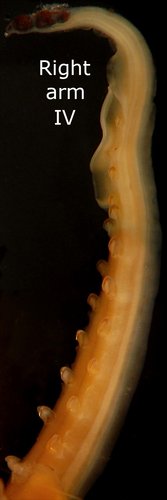
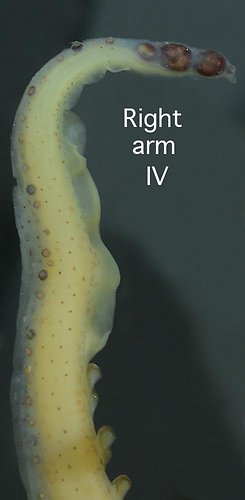
Figure. Arms III and IV of Abraliopsis sp. E, mature male, 21 mm ML, central Equatorial Pacific. Left - Oral views of left arms III and IV. Middle - Dorso-oral view of right arm IV (hectocotylus). Right - Ventral view of the distal portion of right arm IV. Note the large trabecula at the proximal end of the ventral flap. Photographs by R. Young.
- Tentacles
- Largest hooks of ventral series of manus about 2.5 times height of dorsal counterparts.
- Manus with 6 or 7 hooks.
- Narrow, short keel restricted to dactylus; narrow carpal flap.
 Click on an image to view larger version & data in a new window
Click on an image to view larger version & data in a new window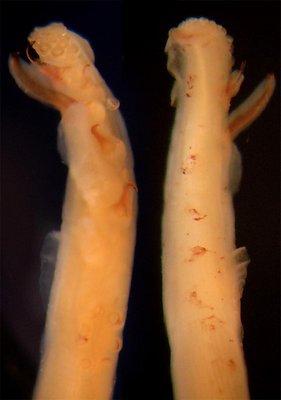
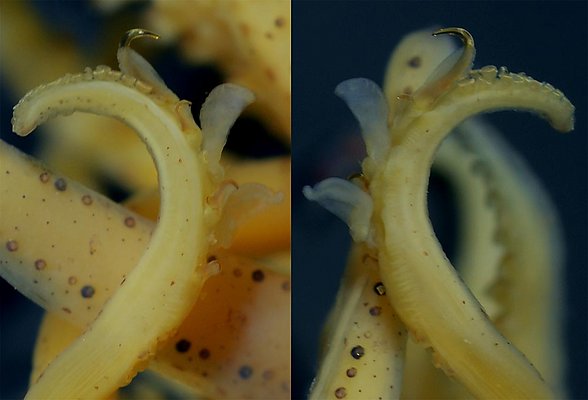
Figure.Tentacular clubs of Abraliopsis sp. E. Left - Oral view of right club showing the carpal flap and keel. Right - Dorsal (left) and Ventral (right) views of left club showing the relative sizes of the hooks. Photographs by R. Young.
- Largest hooks of ventral series of manus about 2.5 times height of dorsal counterparts.
- head
- Occipital crest with occipital folds 3 and 4 joined posteriorly by distinct crescent-shaped ridge.
- Occipital crest with occipital folds 3 and 4 joined posteriorly by distinct crescent-shaped ridge.
- Fins
- Fins large, nearly 70 % of ML.
- Photophores
- Ocular photophores: 5 photophores with end members about 2X larger than adjacent photophores.
- Integumental photophores: 3 series on ventral head, 6 on ventral mantle.
 Click on an image to view larger version & data in a new window
Click on an image to view larger version & data in a new window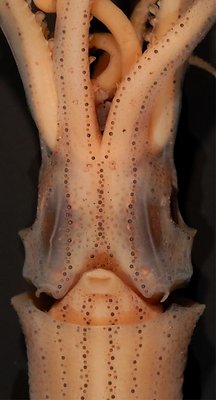
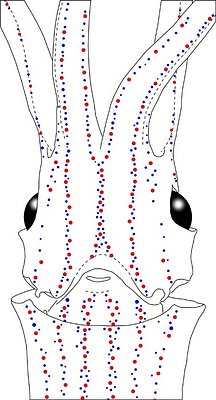
Figure. Ventral view of the mantle and funnel of Abraliopsis sp. E. Left - Photograph of the preserved squid. Middle - Outline drawing from photograph with all integumental photophores represented by colored dots. Red dots - Complex photophores. Blue dots - Non-complex photophores. Images by R. Young.
More information on integumental photophores can be found here.
- Viscera
- Mantle cavity
- Spermatophore
- Mantle cavity
- Measurements (mm) and counts.
R/L
Sex
Male, mature
Mantle length
21
Head width index
42.9
Fin Length index
68
Fin width index
100 Arm Length index (R/L):
I
58.6/60.5
II
66.7/69.5
III
66.7/67.6
IV
83.3/81
No. arm hooks (R/L):
I
19/19
II
-/20
III
19/18
IV
18/24
Club length index (R/L)
24.8/26.7
Club hooks (D/V)(R:L)
3/3; 3/3 Carpal suckers (R/L)
5/5
Comments.
Superficially Abraliopsis sp. E looks like a member of the subgenus Pfefferiteuthis; however it lacks the highly modified arms IV of that group. It is easily separated from other members subgenus Micrabralia by the characters listed in the "Brief diagnosis" above.
See Abraliopsis (Micrabralia) page for comparisons among all species of the subgenus.
Title Illustrations

| Scientific Name | Abraliopsis sp. E |
|---|---|
| Location | Central Equatorial Pacific at 7°15'N, 149°54'W |
| Specimen Condition | Preserved |
| Sex | Male |
| Life Cycle Stage | Mature |
| View | Ventral |
| Size | 21 mm ML |
| Collector | Thomas A. Clarke |
| Image Use |
 This media file is licensed under the Creative Commons Attribution License - Version 3.0. This media file is licensed under the Creative Commons Attribution License - Version 3.0.
|
| Copyright |
©

|
About This Page

University of Hawaii, Honolulu, HI, USA
Correspondence regarding this page should be directed to Richard E. Young at
Page copyright © 2016
 Page: Tree of Life
Abraliopsis sp. E.
Authored by
Richard E. Young.
The TEXT of this page is licensed under the
Creative Commons Attribution-NonCommercial License - Version 3.0. Note that images and other media
featured on this page are each governed by their own license, and they may or may not be available
for reuse. Click on an image or a media link to access the media data window, which provides the
relevant licensing information. For the general terms and conditions of ToL material reuse and
redistribution, please see the Tree of Life Copyright
Policies.
Page: Tree of Life
Abraliopsis sp. E.
Authored by
Richard E. Young.
The TEXT of this page is licensed under the
Creative Commons Attribution-NonCommercial License - Version 3.0. Note that images and other media
featured on this page are each governed by their own license, and they may or may not be available
for reuse. Click on an image or a media link to access the media data window, which provides the
relevant licensing information. For the general terms and conditions of ToL material reuse and
redistribution, please see the Tree of Life Copyright
Policies.
- First online 03 November 2013
- Content changed 03 November 2013
Citing this page:
Young, Richard E. 2013. Abraliopsis sp. E. Version 03 November 2013 (under construction). http://tolweb.org/Abraliopsis_sp._E/144396/2013.11.03 in The Tree of Life Web Project, http://tolweb.org/




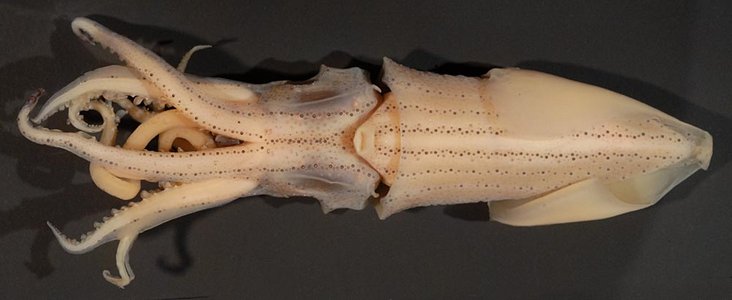
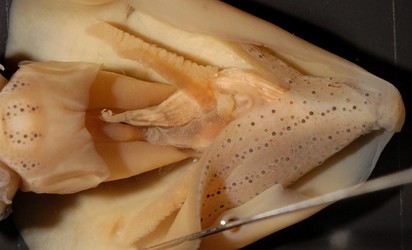

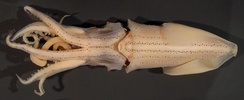


 Go to quick links
Go to quick search
Go to navigation for this section of the ToL site
Go to detailed links for the ToL site
Go to quick links
Go to quick search
Go to navigation for this section of the ToL site
Go to detailed links for the ToL site